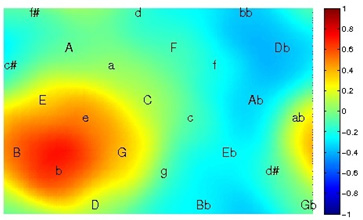Music may be the key to treating epilepsy by forecasting impending seizures
1 February 2013 | Cambridge
Musicians and scientists use high speed data networks to collaborate on melody analysis tool
Thanks to the combined power of supercomputing and the high-speed GÉANT network, a group of musicians, network experts, computer scientists and neuroscientists have collaborated in the study of epilepsy using melody analysis (data sonification).
 |
| Data image: Mapping EEG data to tonal maps (frame from animation) |
Initiated by the ARCEM - Italian Association for the Research on Brain & Spinal Cord Diseases, Vittuone (MI), Italy, and in collaboration with the Mario Negri Institute for Pharmacological Research, Milan, Italy, the *project studies musical patterns which can be associated to data taken from a patient’s **EEG recordings.
Huge volume of data
In the study, long sequences of data are generated and analysed using different sets of parameters and high quality audio and animation files created for every EEG data sequence. This huge volume of data relies upon multiple computers combining their processing power using the bandwidth of the super-fast pan-European GÉANT network and its National Research and Education Network (NREN) partners to access, store and transport it.
Says Massimo Rizzi, the Mario Negri Institute for Pharmacological Research and ARCEM: “Using the GÉANT network we are able to seamlessly transport data to and from scientists all over Europe, enabling a level of collaboration to facilitate medical innovation and scientific research that could have direct implications for the 50 million people worldwide suffering from epilepsy.”
This novel method of combining data sonification with recurrence quantification analysis is expected to deliver better results and additional data compared with traditional or existing methods for studying epilepsy, and thereby promoting the research for new therapeutic interventions.
Sonification tool
The sonification tool is used to identify a baseline condition or ‘marker’ denoting specific epileptic EEG states. The identification of a marker may help to highlight and characterise the temporal patterns embedded in the EEGs of epileptic patients, helping to forecast a seizure far in advance. This pioneering process could provide a powerful tool for seizure prevention, improving the quality of life for the millions of people suffering from one of the most common and serious neurological disorders.
Data sonification is the process of converting numerical data in to sound signals. It is similar to creating a graph, except that melody constituents are notes and tones instead of lines and points. The human ear is naturally trained to recognise patterns and detect abnormalities. So where searching for a particular value on a graph can prove difficult visually, nearly everybody can spot a wrong note in a song without any musical training.
Grid computing
Sonification is a powerful tool used in many scientific disciplines and applications from surveillance to monitoring. It generates vast amounts of data that requires the processing power of supercomputers. This study relies on the European Grid Infrastructure (EGI), a collection of computers grouped together in resource centres, connected to each other through high-performance network links (such as GÉANT), and accessed by authorised research users.
High-speed networks accelerating research
Only a few years ago many scientific researchers relied on physically transporting data cassette tapes for analysis. Today thanks to the high-speed research and education networks such as GÉANT and its NREN partners, this data can be transferred in real time between scientists and researchers located at different institutes and countries.
Further information:
Tamsin.henderson@dante.net or paul.maurice@dante.net
Tel: +44 1223 371300
References
* The project – ‘A Framework for the analysis of medical data using data sonification across the GÉANT network and the European Grid Structure’
Research conducted by: Roberto Barbera, Department of Physics & Astronomy of the University of Catania and Italian National Institute of Nuclear Physics, Division of Catania, Italy; Francesca Falcetta, The Mario Negri Institute for Pharmacological Research, Milan, Italy; Giuseppe La Rocca, Italian National Institute of Nuclear Physics, Division of Catania, Italy, Massimo Rizzi, The Mario Negri Institute for Pharmacological Research, Milan, Italy and ARCEM – Italian Association for the Research on Brain & Spinal Cord Diseases, Vittuone (MI), Italy; Mariapaola Sorrentino, ASTRA Project and LHC Open Symphony, Cambridge UK; Domenico Vicinanza, DANTE, City House, 126-130 Hills Road, Cambridge, UK
** EEG (electroencapholography) – EEG recording in a clinical context refers to recording of the brain’s spontaneous electrical activity over a period of time. In this context an ‘inter-ictal’ EEG recording is such that is done sufficiently far from a seizure.
MARIO NEGRI Institute for Pharmacological Research - www.marionegri.it
ARCEM - www.arcem.it
GARR – www.garr.it
EGI – www.egi.eu

